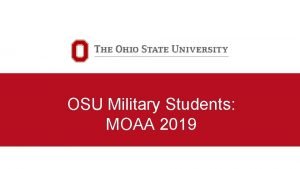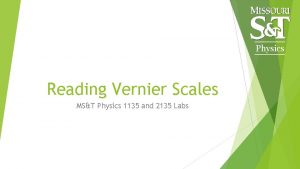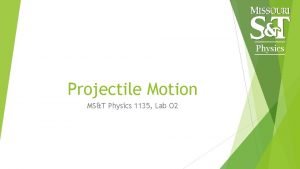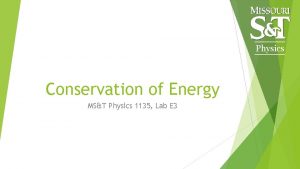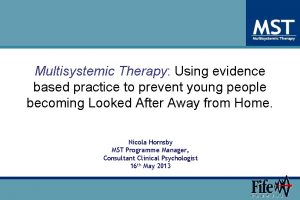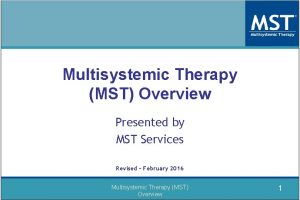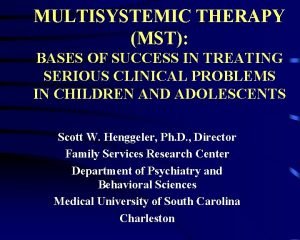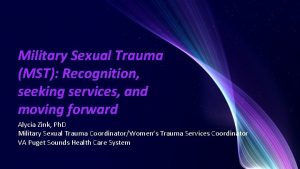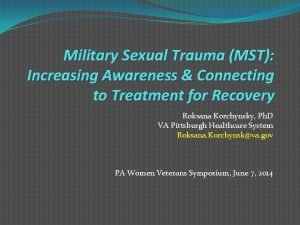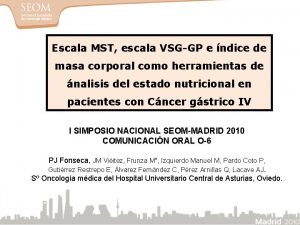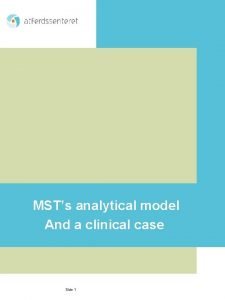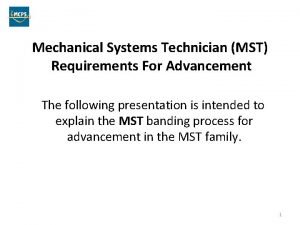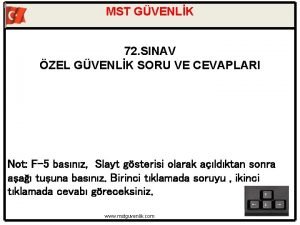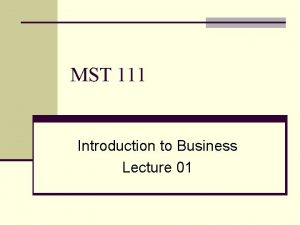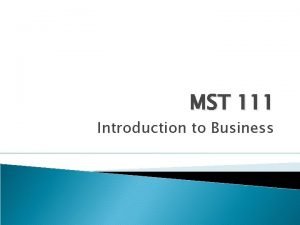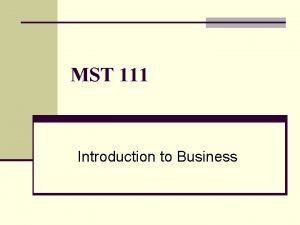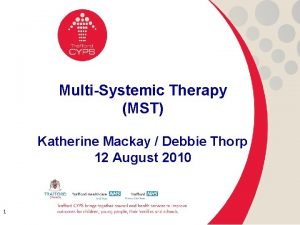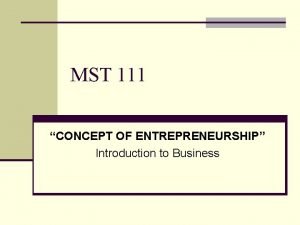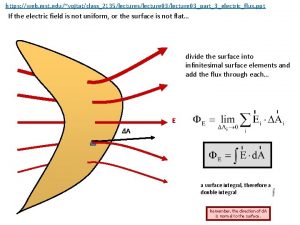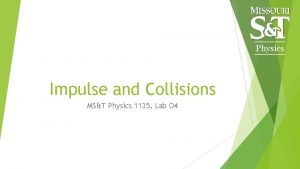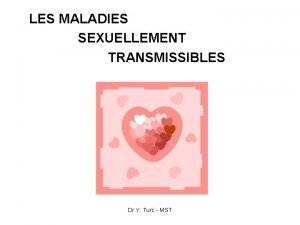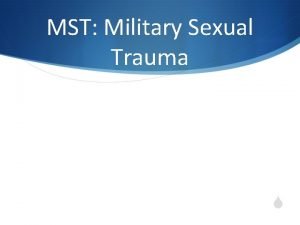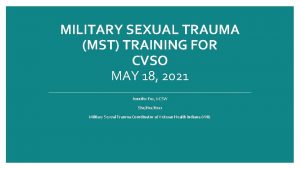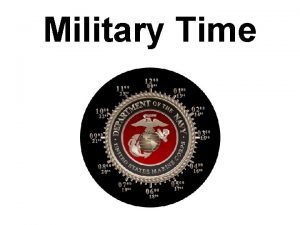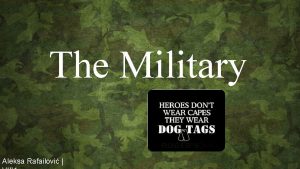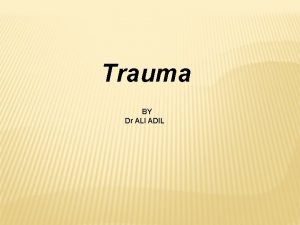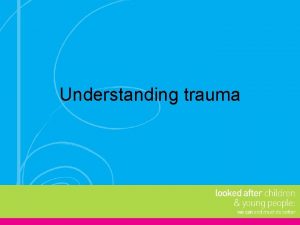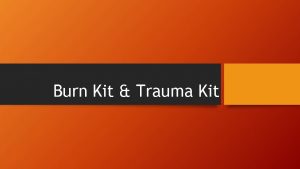Military Sexual Trauma MST Recognition seeking services and







































- Slides: 39

Military Sexual Trauma (MST): Recognition, seeking services, and moving forward Alycia Zink, Ph. D Military Sexual Trauma Coordinator/Women’s Trauma Services Coordinator VA Puget Sounds Health Care System

Brief description of your presentation: This presentation will provide an overview of Military Sexual Trauma (MST) including definitions, statistics, and aspects of sexual trauma that are unique to military service. The presenter will also discuss common reactions to sexual trauma, including mental health conditions such as PTSD. Lastly, the presentation will provide a brief overview of the types of mental health treatments available for sexual assault survivors.

Objectives • Participants will be able to specify aspects of sexual trauma that are unique to military settings • Participants will be able to identify common short-term and long-term reactions to sexual trauma. • Participants will be able to identify at least one form of treatment available to Veterans with MST.

Disclaimer Dr. Alycia Zink is a staff psychologist serving as the Military Sexual Trauma Coordinator and Women’s Trauma Services Coordinator with the PTSD Outpatient Clinic at VA Puget Sound Health Care System, American Lake Division. The information presented here includes information obtained from the National MST Screening & Treatment Data and Maketheconnection. net.

Objective 1 WHAT IS MILITARY SEXUAL TRAUMA?

What is Military sexual Trauma (MST)? Military Sexual Trauma (MST) is a term used by the VA and refers to a broad range of experiences from sexual harassment to sexual assault. v Sexual harassment is defined as repeated, unwanted verbal or physical contact that is sexual in nature and considered intimidating or threatening. v Sexual assault refers to attempted rape, fondling or unwanted sexual touching, forcing a victim to perform sexual acts, or penetration of the victim’s body, also known as rape.

Types of MST experiences: v. Threatening or offensive remarks about someone’s body v. Threatening and unwelcome sexual advances v. Unwanted touching or grabbing v. Unwanted sexual penetration with an object or body part v. Physically forced into participation v. Unable to consent to sexual activities (under the influence of drugs, alcohol, etc. ) v. Pressured or coerced into sexual activities

What is MST? The experiences listed on the previous slide must occur during the Veterans military service v. The identity of the perpetrator does not matter v. It does not need to have been reported to the military or civilian law enforcement

How common is MST: National Stats FY 19 Gender FEMALE ALL GENDERS Total Veterans Seen Screened in a MST Screening Target Clinic Percent of Veterans Screened Total Veterans Most Recent Screen MST+ Percent of Screened Veterans with Current Screen MST+ 461, 219 455, 304 98. 72% 137, 100 30. 11% 4, 800, 949 4, 744, 614 98. 83% 78, 679 1. 66% 5, 262, 168 5, 199, 918 98. 82% 215, 779 4. 15%

Washington State MST Statistics FY 19 Gender Total Veterans Seen in an MST Screening Target Clinic Total Veterans Screened Percent of Veterans Screened Total Veterans Percent of Most Recent Screened Veterans Screen with Current MST Positive Screen MST Positive Female 22, 783 22, 259 98. 89% 8, 638 38. 34% Male 222, 448 218, 243 99. 00% 5, 508 2. 52% All Genders 243, 231 240, 772 98. 99% 14, 146 5. 88%

Puget Sound Area MST Statistics FY 19 Facility Seattle, WA American Lake, WA Bellevue, WA Bremerton, WA Mount Vernon, WA South Sound, WA North Olympic Peninsula, WA Puget Sound, WA - Mobile Total Current Screen MST+ Female Male 2, 453 1, 577 876 2, 111 1, 519 592 519 325 194 276 170 106 352 218 134 177 110 67 105 58 47 30 11 19

Some distinctions The term “MST” is used by the VA to describe experiences that may need medical or mental health treatment v. The term MST is not necessarily used by Do. D or local law enforcement MST is not really a “diagnosis”, it is an event someone experiences v Individuals may have different reactions to MST

Why is MST so common? In 2012, the CDC identified a number of risk factors associated with the perpetration of sexual violence, including: Individual Risk Factors Community Factors • Societal Factors • • Alcohol and drug use Lack of empathy General aggressiveness and acceptance of violence Preference for impersonal sex and sexual-risk taking Exposure to sexually explicit media Hostility towards women Adherence to traditional gender role norms Hyper-masculinity • • Lack of institutional support from police and judicial system General tolerance of sexual violence within the community Weak community sanctions against sexual violence perpetrators Societal norms that support sexual violence Societal norms that support male superiority and sexual entitlement Societal norms that maintain women’s inferiority and sexual submissiveness Weak laws and policies related to sexual violence and gender equity

Meachelle’s story https: //www. youtube. com/watch? v=L 2 oqvq 2 t. Yo&feature=youtu. be

Ana’s story https: //maketheconnection. net/stories/696

Questions?

Objective 2 REACTIONS TO MST

Carla’s Story https: //www. youtube. com/watch? v=J-MWsoum. LGU

Common Reactions and Symptoms Shock v v Fear v Anxiety v Anger v Shame v Guilt v Depression Alcohol or substance v use v v Feeling edgy v v v v Grief Physical pain/ injury Being easily startled Suicidal Thoughts Headaches Rapid heart beat Problems sleeping Difficulty breathing Poor concentration v Feeling numb or detached v Difficulties with trust v Decreased selfesteem v Lack of intimacy v Changes in eating v Nausea v Nightmares

Is it normal? v These symptoms are NORMAL reactions to difficult circumstances v It is important to talk to someone if these reactions persist v If seeking help, mental health providers will assist in discussing symptoms and to identify the type of treatment that is the best for the symptoms being expereinced

Symptoms and diagnoses v Individuals may experience some or all of the symptoms noted previously v Diagnoses are made based on the unique reactions each individual experiences v Common examples of diagnoses following MST include: o Major Depressive Disorder, Post-traumatic stress disorder, Alcohol Use Disorder, Obsessive-Compulsive Disorder o Some individuals may have more than one diagnosis o These diagnoses are treatable

Veterans stories • https: //www. youtube. com/watch? v=2 R-Sqt. Ahkj 8

Questions?

Objective 3 WHAT IS BEING DONE FOR SURVIVORS?

What is the Department of Defense Doing? • Information about the Department of Defense’s current efforts related to sexual assault in the military is available at www. myduty. mil and www. sapr. mil 25

The two faces of the VA v The Veterans Administration is actually made of two separate agencies: o Veterans Benefits Administration (VBA) o Veterans Hospital Administration (VHA)

What is VBA Doing? v Veterans can file a claim to receive compensation for any MST-related injuries or disabilities that began or got worse during their military service v The Veterans Benefits Administration (VBA) is responsible for handling these claims o More information is available at http: //www. benefits. va. gov/BENEFITS/factsheets/serviceconnected/ MST. pdf v Every VBA Regional Office has a male and female MST Coordinator who can assist Veterans with MST-related claims 27

What is VHA Doing? v Universal screening v Free MST-related care (medical and mental health) v MST Coordinator at every VA Medical Center (VAMC)/Healthcare System (HCS) v National MST Support Team, to continue improving VHA’s response to MST v Education and training of staff v Outreach to Veterans 28

Meeting with a mental health professional v Veterans need to first register with the VA closest to their home location v Some facilities/sites have different ways of accessing mental health. In most sites, there is same day access meaning that a Veteran can walk in and request to see someone in mental health that day. v Many facilities also have mental health providers on Primary Care Team or in Women’s Specialty Clinics

Mental Health Treatment v The first visit with mental health is called an “intake”. This appointment is designed to help ensure that the provider is able to tailor treatment to the unique needs of each Veteran v During this appointment, the provider will ask about background information and current symptoms. Based on this information, the provider will provide the diagnosis

Mental Health Treatment v Based on the diagnosis and what the Veterans would really want to get from treatment, a “treatment plan” will be developed. v The treatment plan will include the different types of treatments that will assist the Veteran in getting what they want from treatment. v It will include options for an evidenced-based treatments specifically designed to treat the symptoms that are bringing the Veteran into treatment v This is a collaborative process seeking to make sure that the available treatments meet the Veterans needs

Type of treatment available from the VA v Psychotherapy o Group o Individual v Medication Management v Outpatient and Inpatient

Evidenced Based Treatments for PTSD v Prolonged Exposure https: //youtu. be/r. Hg_Sl. Eq. JGc v Cognitive Processing Therapy https: //youtu. be/Jqj 5 z. Dbk. Px. Y

Other psychotherapies with promise v DBT v ACT v Narrative exposure v EMDR

Robert’s Story https: //maketheconnection. net/stories/735

Washington State VA MST Coordinators Spokane VAMC Dawn Gray, LICSW 4815 N Assembly St (BHS-116) Spokane, WA 99205 (509) 434 -7281 Dawn. Gray 3@va. gov Jonathan M. Wainwright VAMC Eric Hollen, LMSW 77 Wainwright Dr Walla, WA 99326 (509) 946 -1020 Eric. Hollen@va. gov Julia Sewell, LICSW VA Puget Sound HCS 1660 S. Columbian Way (S 116) Seattle, WA 98108 (206) 277 -1816 Julia. Sewell@va. gov Alycia Zink, Ph. D VA Puget Sound HCS 9600 Veterans Drive SW (61 -116 A) Tacoma, WA 98493 (253) 583 -3568 Alycia. Zink@va. gov

Washington (Seattle Regional Benefit Office) • Rochelle Mantanona Rochelle. M. Mantanona@va. gov • Robert Kohler Robert. Kohler@va. gov • Eileen Jordan Eileen. Jordan@va. gov

Addittional Resources Do. D Ø https: //www. safehelpline. org/ VA Ø Make the connection Ø http: //vaww. mst. va. gov. Community Ø https: //www. findsafety. org/ Ø #Notinvisible Ø 1 in 6 Ø https: //www. nwnetwork. org/

Referrences Tharp, A. T. , De. Gue, S. Valle, L. A. , Kathryn A. Brookmeyer, K. A. , Massetti, G. M. , Matjasko, J. L. (2012). A Systematic Qualitative Review of Risk and Protective Factors for Sexual Violence Perpetration, Trauma, Violence, and Abuse Volume: 14 (2), 133 -167. Stander, V. A. & Thomsen, C. J. (2016). Sexual Harassment and Assault in the U. S. Military: A Review of Policy and Research Trends MILITARY MEDICINE, 181, 1 -20. https: //www. cdc. gov/violenceprevention/sexualviolence/riskprotectivefactors. html
 Osu military
Osu military Physics 2135 mst
Physics 2135 mst Mst tu delft
Mst tu delft Mst visualization
Mst visualization Mst powerpoint template
Mst powerpoint template Algorithm complexity
Algorithm complexity How to read vernier scale on spectrometer
How to read vernier scale on spectrometer Mst physics 1135
Mst physics 1135 Mst physics 1135
Mst physics 1135 Mst 9 principles
Mst 9 principles What is mst
What is mst Mst analytical process
Mst analytical process Prim's algorithm pseudocode
Prim's algorithm pseudocode Rochelle mantanona
Rochelle mantanona Mst cont
Mst cont Algorithm analysis
Algorithm analysis What is mst
What is mst Prim's algorithm pseudocode
Prim's algorithm pseudocode Escala mst
Escala mst Mst analytical process
Mst analytical process Mst mechanical engineering
Mst mechanical engineering Mst
Mst Tamirul millat mohila kamil madrasah
Tamirul millat mohila kamil madrasah Mst physics 2135
Mst physics 2135 Toplu tabancalarda tırnak nerededir
Toplu tabancalarda tırnak nerededir Mst 111
Mst 111 Mst 111
Mst 111 Mst 111
Mst 111 Generic mst
Generic mst Neel order
Neel order Mst mackay
Mst mackay Mst 111
Mst 111 Mst
Mst Mst damon
Mst damon Mst screening
Mst screening Web mst
Web mst Mst bike
Mst bike Electric field intensity formula
Electric field intensity formula Mst physics 1135
Mst physics 1135 Vaginose contagion
Vaginose contagion
